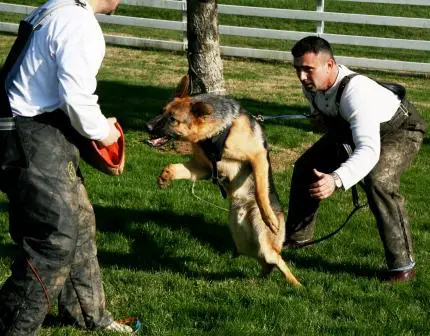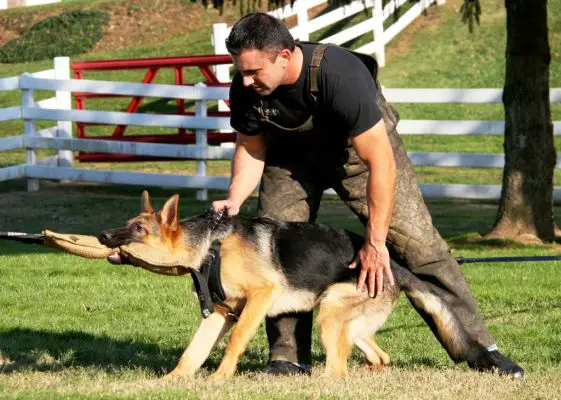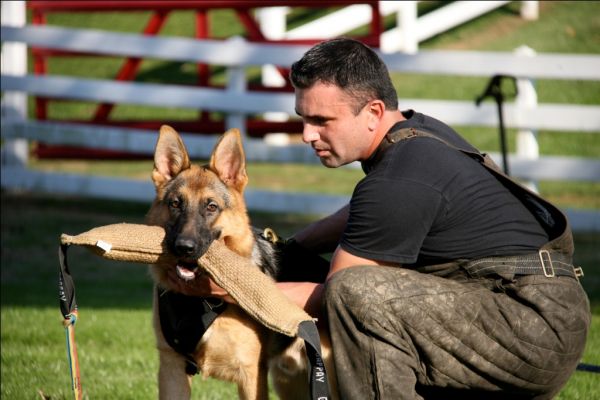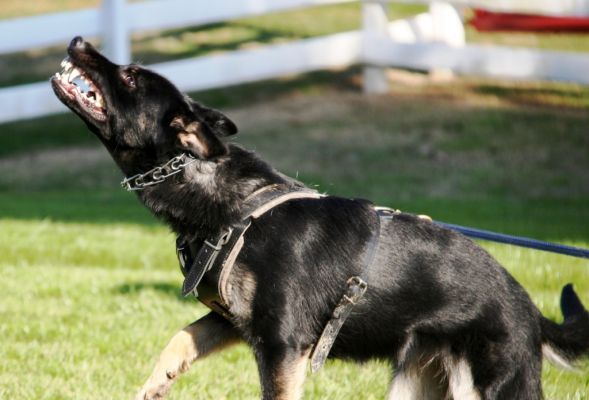
This is a placeholder text
Group text
by waldo2121 on 03 April 2012 - 02:04
Does anyone have any tips on how to get your GSD to hold onto the sleeve or pillow? Our youngest male (1 year) is very mouthy once he bites the sleeve or pillow and I'm trying to figure out a way to break him of it so he will stop dropping it or regripping it as soon as he bites it. He does it with toys in the house too, which I fear is where it started. He'll grab a toy, bring it to us and drop it. I think this bitework issue is a result of us rewarding him for bringing the toy to us and dropping it for us without outing it. Any thoughts or tips are greatly appreciated!
by dcw on 03 April 2012 - 04:04
There are several ways you can work on establishing and maintaining grip. Many people put the dog on a harness, often on a tie-out. When the helper gives the grip via the pillow, he pulls back, thus making it much more difficult for the dog to be "chewey", as he must bite down. Oftentimes, a line is attached to the pillow, and a good helper will silide back on the line, while still keeping it taut. One reason for a line, especially for a young dog, is to avoid conflict in the grip, as some dogs feel conflict just by the helper's presence. Sliding back on the line helps reduce this pressure. The handler can then try to approach the dog, and hopefully establish a calm "cradle" for the dog. When you are ready, the dog outs and you start over again. Although this is a quick basic run-down on the technique, there are actually many factors that a good helper, handler team take into accout; the nerve of the dog, the drive, the trust factor of their handler, etc. Like has often been said, a good helper makes all the difference. It takes a lot of feeling, not just mechanics.
DCW
DCW
by live4schutzhund on 03 April 2012 - 09:04
He is dropping it because to him it is dead. Regripping, dropping, or letting go are very different things. You need a good helper.
DCW gave alot of condensed information to you. Here are some pictures of what he is saying.
Awesome helper with pillow, I am close to the dog reassuring and lending confidence holding harness.
.jpg)
DCW reference to sliding back on line. Both helper and I are back from the dog to minimize preassure.
.jpg)
Near misses build drive in the dog.

As you can see his reaction to the miss here. Helper is slapping the wedge, as you would the stick to a sleave. With vocals and a million other things a good helper does all the while reading the dog, you need a good helper.
.JPG)
Hear I am checking the grip. His ears are forward, bite is calm and deep with no chewing.

He has won. Remove all drive. Reinforce calm deep bite. He wasnt letting go, no sir.

Then sometimes they do this and you cant help yourself. How the hell can you stay serious.
.jpg)
As for building a better grip on a sleave, here is a picture. I am letting the dog feel my arm. It hurts, but only let go when they really get you arm, not just sleave.

Here is a cool tie out pic of an awesome little female we nickname devil dog. She is a sweety though.

Keep in mind I am very much just a novice handler and helper. When you meet people that really know there stuff, you will see what I am saying. Good luck, hope these pictures gave a visual to what DCW was saying.
DCW gave alot of condensed information to you. Here are some pictures of what he is saying.
Awesome helper with pillow, I am close to the dog reassuring and lending confidence holding harness.
.jpg)
DCW reference to sliding back on line. Both helper and I are back from the dog to minimize preassure.
.jpg)
Near misses build drive in the dog.

As you can see his reaction to the miss here. Helper is slapping the wedge, as you would the stick to a sleave. With vocals and a million other things a good helper does all the while reading the dog, you need a good helper.
.JPG)
Hear I am checking the grip. His ears are forward, bite is calm and deep with no chewing.

He has won. Remove all drive. Reinforce calm deep bite. He wasnt letting go, no sir.

Then sometimes they do this and you cant help yourself. How the hell can you stay serious.
.jpg)
As for building a better grip on a sleave, here is a picture. I am letting the dog feel my arm. It hurts, but only let go when they really get you arm, not just sleave.

Here is a cool tie out pic of an awesome little female we nickname devil dog. She is a sweety though.

Keep in mind I am very much just a novice handler and helper. When you meet people that really know there stuff, you will see what I am saying. Good luck, hope these pictures gave a visual to what DCW was saying.
by judron55 on 03 April 2012 - 12:04
first and foremost is determining whether the dog has a genetic grip or is mouthy no matter what...you can only ruin grips...you can't make them:-) The techniques described to reinforce behavior is good though, the whole carry and hold aspect is subjective....
by Bob McKown on 03 April 2012 - 13:04
Grips are 100% genetic you can cover up lots of problems you can create lots of problems but in the end under pressure the grip will be what it will be.You can,t change genetics. Thats why it is SO important to apply pressure in the test to properly judge the dogs strength.
And when proper pressure is applied no matter how well it,s covered grip issues will show. JMHO
by Feuerhaus on 04 April 2012 - 12:04
Grips are 100% genetic you can cover up lots of problems you can create lots of problems but in the end under pressure the grip will be what it will be.You can,t change genetics. Thats why it is SO important to apply pressure in the test to properly judge the dogs strength.
And when proper pressure is applied no matter how well it,s covered grip issues will show. JMHO
Agree 100% Bob
And when proper pressure is applied no matter how well it,s covered grip issues will show. JMHO
Agree 100% Bob
by waldo2121 on 06 April 2012 - 18:04
Thanks for all the information and suggestions! Luckily, I know it's not a matter of his genetics, becuase he's got some excellent genes from some very well known DDR, Czech and slovak kennels (i.e., Jipo me (Jinopo cz), Pohranicni straze, etc.). We're working with a good helper, so I'm sure we'll get it figured out, but I wanted to do some of my own research to learn for myself and to get others thoughts.
Thanks-
Contact information Disclaimer Privacy Statement Copyright Information Terms of Service Cookie policy ↑ Back to top




